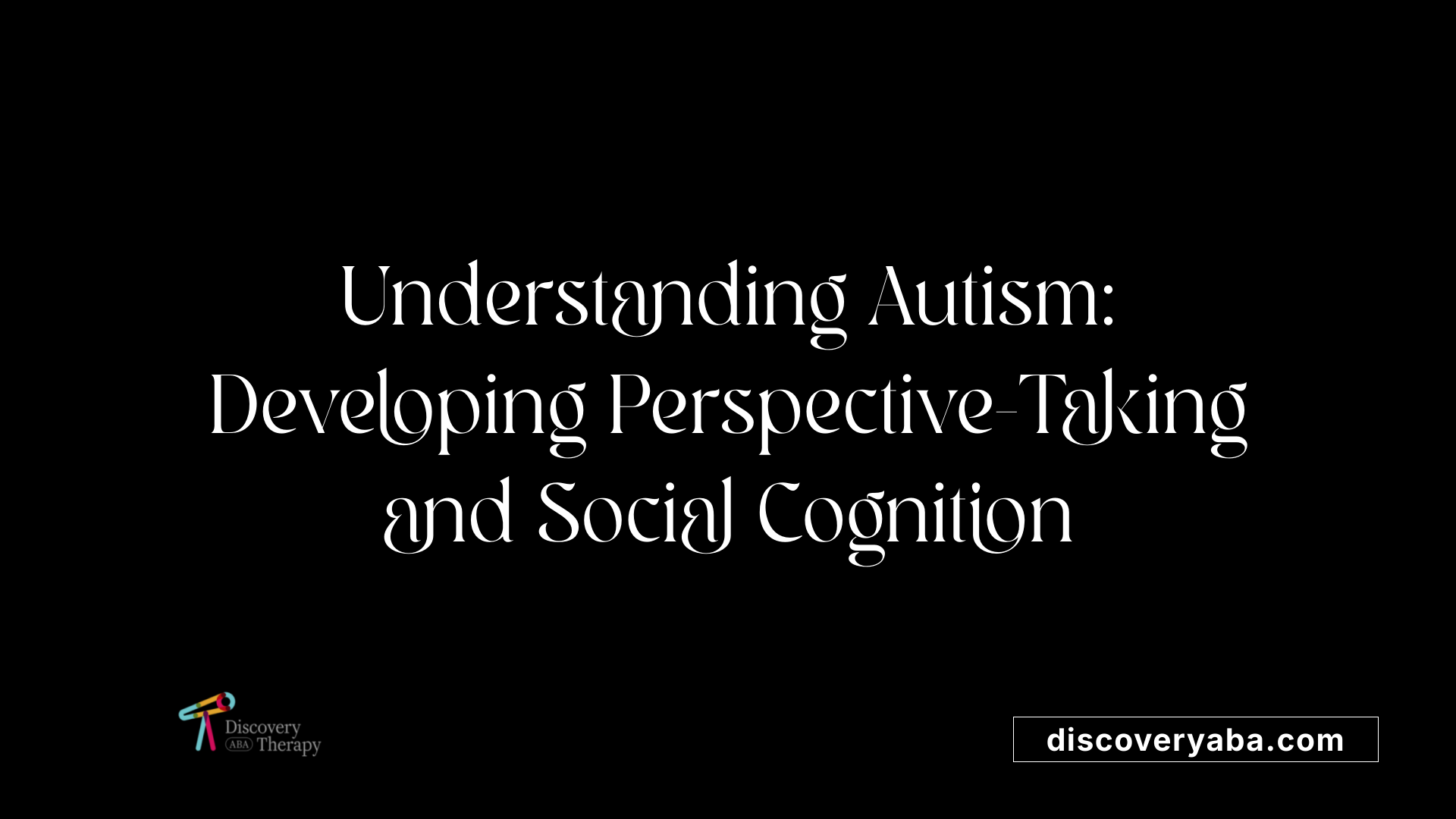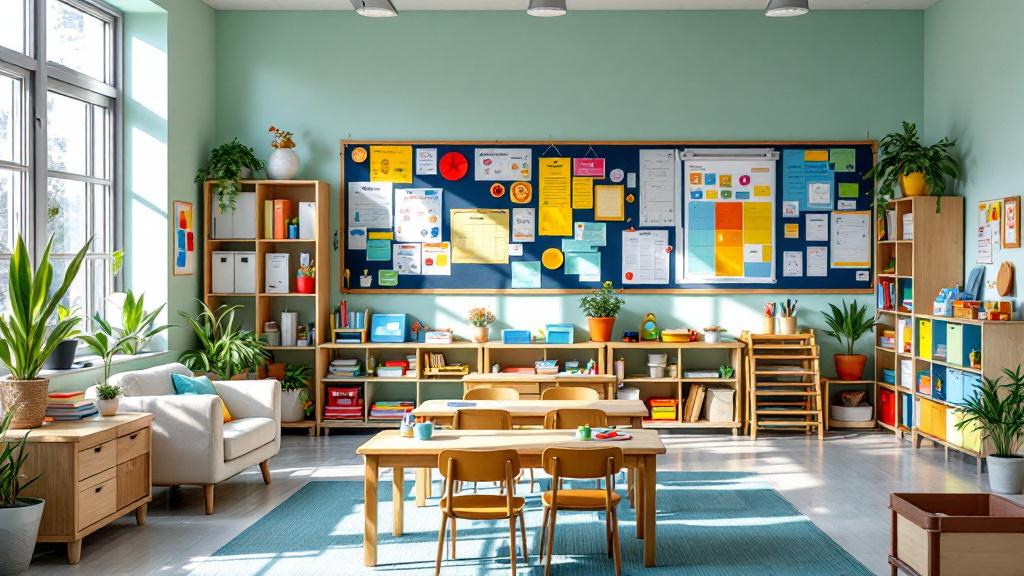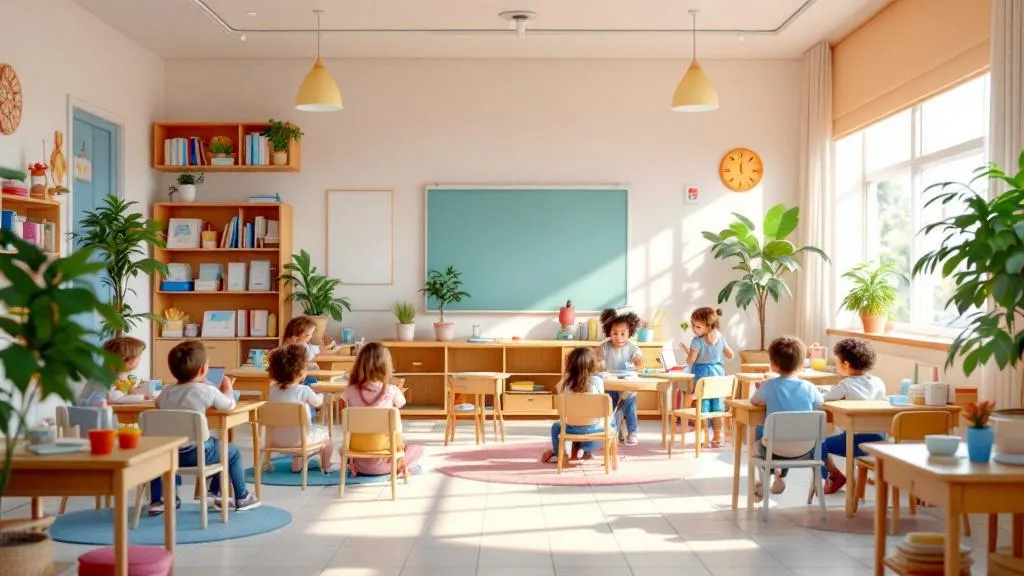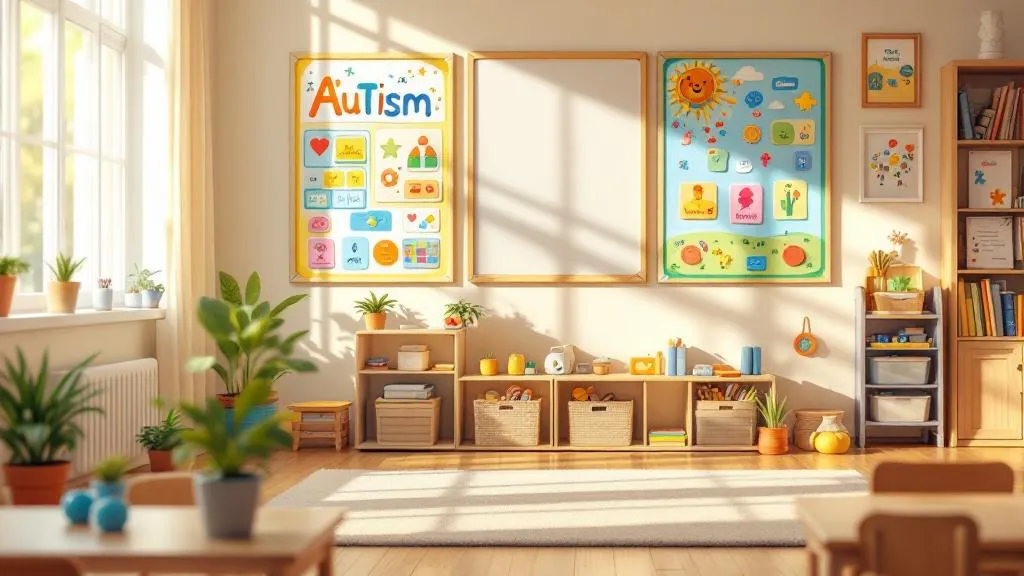Teaching perspective-taking to children with autism
Bridging Minds: Strategies and Innovations in Teaching Perspective-Taking to Children with Autism

Understanding and Supporting Perspective-Taking in Autism
Perspective-taking is a crucial social skill that enables children to recognize, understand, and respond to the emotions, thoughts, and viewpoints of others. For children with autism, developing this ability is often challenging yet essential for meaningful social interactions and emotional growth. This article explores evidence-based strategies, developmental considerations, and practical resources designed to foster perspective-taking among children on the autism spectrum, emphasizing neurodiversity and autism acceptance.
Foundations of Perspective-Taking and Theory of Mind in Autism

What are the developmental stages and challenges involved in teaching perspective-taking?
Children begin to develop the ability to understand others’ perspectives around age 2 to 3. During this early stage, they recognize that others can have different thoughts and feelings. As they grow, typically by school age, they start understanding that others may hold beliefs that are different from their own, and these beliefs can sometimes be incorrect. This progression constitutes what is known as Theory of Mind (ToM).
However, children with autism often face more significant hurdles in this development. They may struggle with understanding and interpreting others’ mental states, emotions, and social cues. This difficulty is linked to deficits in ToM, which is a crucial component for successful social interactions.
Teaching strategies tailored for these developmental stages include using visual supports like emotion pictures, social stories, role-play, and engaging activities that are socially relevant. For example, storytelling that highlights characters' feelings and thoughts helps children connect behaviors to internal states. These methods support gradual understanding while making social information accessible.
What resources are available for parents, educators, and professionals to support perspective-taking development in children?
A variety of resources help foster perspective-taking and empathy in children. Books like ‘What is a Thought?’, ‘Duck! Rabbit!’, and ‘Stand In My Shoes’ serve as excellent tools for teaching about different mental states and viewpoints through engaging stories. Visual aids, such as optical illusions, emotion masks, and photographs, make abstract concepts more tangible.
Interactive digital apps like Avokiddo Emotions, Quandary, and Peppy Pals provide engaging platforms for practicing social-emotional skills. Educational games such as Guess Who?, Pandemic, and Dixit encourage children to explore perspectives through fun, strategic play.
Clinicians and educators also utilize structured activities like role-playing, social narratives, and guided discussions. These are often supplemented with printable worksheets and visual prompts to reinforce learning. Programs such as ‘Choice to Be Nice’ and ‘Operation Respect’ promote social-emotional learning, emphasizing kindness and understanding. Staff training and family involvement play significant roles in ensuring these strategies are consistent and integrated into daily routines.
What techniques can be used in educational and therapeutic settings to improve social and emotional understanding?
In both settings, techniques like video modeling, social stories, and role-playing are highly effective. Video modeling demonstrates appropriate social behaviors and emotional responses by showing real-life scenarios to children.
Explicit teaching about emotions, including labeling facial expressions, recognizing feelings, and understanding context, is essential. Visual supports—like emotion charts and guided scripts—help clarify social cues and facilitate discussions about feelings.
Creating consistent, inclusive environments encourages children to practice social skills in safe settings. Incorporating mindfulness, emotional regulation exercises, and active listening supports self-awareness and empathy. Also, involving peers in cooperative activities promotes natural social learning.
What are effective methods and strategies for teaching perspective-taking to children with autism?
Strategies include using visual tools such as facial expression charts, props like glasses or perspective glasses, and social stories designed to illustrate social situations from multiple viewpoints. Games such as ‘Pass the Face’ and activities involving imitation help children recognize and mimic emotions, fostering both understanding and emotional response.
Video modeling and role-play are central, offering real-life context and repeated practice. Explicitly teaching specific social skills, like understanding deception or sharing opinions, enhances explicit perspective-taking.
Importantly, these methods should respect neurodiversity—tailoring interventions to individual strengths and communication styles, whether verbal or alternative. Naturalistic teaching moments, where social skills are embedded into everyday interactions, further promote meaningful learning.
How can approaches to teaching perspective-taking be aligned with neurodiversity and autism acceptance?
Alignment with neurodiversity principles emphasizes accepting and valuing different ways of perceiving the world. Interventions focus on supporting autistic individuals to develop their unique perspectives and communication methods rather than imposing normative standards.
This includes using visual supports, social stories, and activities that emphasize understanding diverse experiences, and educating peers about neurodiversity to foster acceptance. Promoting self-determination and respecting sensory preferences and communication styles is vital.
By creating inclusive environments and empowering autistic individuals, educators and parents help reduce social isolation and stigma, broadening societal understanding of diverse minds.
What evidence exists regarding effective interventions for improving perspective-taking skills?
Research indicates that visual supports, social stories, and video modeling are effective in enhancing perspective-taking. For instance, a study involving preschool children (including those with high-functioning autism) showed significant improvements in both affective and cognitive perspective understanding after targeted training.
Programs that involve story reading, dramatization, and graphic activities lead to increased prosocial behaviors, such as helping and sharing. Long-term effects suggest that these interventions can generalize to everyday social interactions.
However, generalization remains a challenge; skills learned in therapy or structured activities may not always transfer seamlessly to natural settings. Combining multiple strategies, including peer interactions and multimedia resources, can enhance progress.
Evidence also supports the importance of respecting neurodiversity, emphasizing authentic social engagement over imitation or masking. Overall, interventions that are flexible, inclusive, and tailored to individual needs tend to yield the best outcomes.
Research and Innovative Methods in Perspective-Taking Interventions

What resources are available for parents, educators, and professionals to support perspective-taking development in children?
Resources designed to foster perspective-taking in children are diverse and accessible. Books such as 'What is a Thought?', 'Duck! Rabbit!', and 'Stand In My Shoes' utilize storytelling to teach empathy and flexible thinking. Visual aids like optical illusions and props, including glasses that simulate different perceptions or emotion masks, make abstract concepts tangible. Interactive tools such as apps—Avokiddo Emotions, Quandary, and Peppy Pals—offer engaging ways for children to explore feelings and social cues. Educational games like 'Perspective Detective' and classic board games such as 'Guess Who?' help develop social reasoning in fun, cooperative settings. Teaching strategies also include social scripts, role-play, and arts activities like paintings from another’s perspective or 'Walk in My Shoes' projects. Online curricula like 'Choice to Be Nice' and 'Operation Respect' promote inclusivity and empathy, complementing printable worksheets and guided discussion activities. All these resources contribute holistically to developing social-emotional skills, emphasizing understanding diversity, emotions, and thoughts in children from various backgrounds and abilities.
What evidence exists regarding effective interventions for improving perspective-taking skills?
Research indicates that effective interventions for autistic children focus on authentic understanding of social interactions without promoting masking behaviors. Visual supports such as social stories and emotion recognition tasks help children grasp others’ feelings and motivations in natural contexts. Encouraging children to describe their perceptions and feelings supports self-awareness and intrinsic motivation, reducing dependency on script-based responses. This approach respects neurodiversity and promotes genuine social engagement. Further, educating neurotypical peers about neurodiversity enhances social acceptance, fostering richer peer interactions. Strategies that prioritize respect for individual differences and authenticity are increasingly viewed as both effective and ethically important, leading to more meaningful social outcomes.
What are the emerging technologies and innovative methods used in perspective-taking training?
Technology offers promising avenues for advancing perspective-taking skills. Video modeling, where children observe and imitate social behaviors depicted in videos, is highly effective in teaching emotion recognition and appropriate responses. Reinforcement alongside video modeling strengthens learning and helps embed social skills. Digital applications, such as interactive apps, virtual reality, and digital escape rooms, provide immersive social scenarios that enhance empathic understanding. Additionally, the design of video games explicitly aimed at fostering perspective-taking encourages players to navigate complex social environments, making them active participants in understanding others' viewpoints. These technological tools are customizable, engaging, and scalable, making them suitable for a wide spectrum of learners and setting new standards in intervention strategies.
How do curricula and community programs facilitate large-scale perspective-taking development?
Educational and community initiatives play a pivotal role in widespread social-emotional learning. Programs like 'Choice to Be Nice,' 'It's Okay to Be Different,' and 'Operation Respect' embed empathy, kindness, and inclusivity in their core objectives. They incorporate classroom activities, cooperative games like 'Dixit' or 'Sheriff of Nottingham,' and community projects that stimulate children’s exploration of multiple perspectives. Curricula often include film discussions, literature, and arts-based projects, encouraging active reflection on others' feelings and experiences. By embedding these values within school systems and community settings, these programs help create environments that celebrate diversity and promote understanding, reducing biases and fostering respect among children and adults alike.
| Resources and Methods | Description | Intended Impact |
|---|---|---|
| Children's Books | 'What is a Thought?', 'Duck! Rabbit!', 'Stand In My Shoes' | Teach empathy and flexible thinking |
| Visual/Affective Tools | Optical illusions, emotion masks, perspective glasses | Enhance understanding of emotions |
| Digital Apps & Games | Avokiddo Emotions, Quandary, Peppy Pals, 'Perspective Detective' | Engage children in social-emotional learning |
| Board and Card Games | Guess Who?, Dixit, Sheriff of Nottingham | Foster perspective-taking and cooperation |
| Curriculum & Community Programs | 'Choice to Be Nice', 'Operation Respect' | Promote broad societal empathy and inclusivity |
| Technologies | Video modeling, virtual reality, digital escape rooms | Improve social cognition through immersive experiences |
This collection of resources, interventions, and innovations illustrates how diverse and comprehensive approaches can significantly bolster perspective-taking skills in children, particularly those on the autism spectrum. The integration of traditional methods with emerging technologies offers a rich toolkit for educators, parents, and therapists dedicated to supporting social understanding and empathy development.
Moving Towards a Culture of Empathy and Respect

How can approaches to teaching perspective-taking be aligned with neurodiversity and autism acceptance?
Recognizing and respecting neurodiversity is fundamental to promoting genuine acceptance of autistic individuals. Approaches to teaching perspective-taking should emphasize valuing different communication styles, sensory sensitivities, and ways of perceiving the world rather than trying to normalize or 'correct' behaviors.
Use of neurodiversity-affirming resources such as social stories, visual supports, and activities that highlight individual strengths help create an inclusive environment. For example, visual aids that demonstrate different facial expressions or emotional cues can be designed to accommodate varied learning preferences. Instead of focusing solely on imitation or normative behaviors, interventions should support authentic, self-determined communication, allowing autistic individuals to express themselves naturally.
Educating peers and classroom communities about neurodiversity fosters an atmosphere of acceptance. This knowledge reduces stigma and social isolation by encouraging understanding that diverse ways of perceiving and interacting are valid. Social integration is improved when environments promote mutual respect and support diverse communication methods like echolalia or AAC devices.
Overall, aligning perspective-taking education with neurodiversity involves creating supportive spaces that celebrate differences and promote respectful, inclusive interactions. By valuing varied ways of understanding emotions and social cues, communities can foster genuine empathy and reduce exclusion.
What is the impact of fostering perspective-seeking behaviors on social relationships and personal growth?
Encouraging children and individuals to engage in perspective-seeking behaviors—especially through curiosity and questioning—can significantly enhance social and emotional development. When someone actively wants to understand another’s thoughts, feelings, and experiences, it builds trust and deepens social bonds.
This approach nurtures authentic understanding, moving beyond superficial responses to create meaningful connections. For children with autism, shifting focus from merely predicting or imitating behaviors to engaging in active inquiry promotes genuine social engagement. Asking questions like, “How do you feel about that?” or “What would you do in my place?” invites others into a dialogue rooted in curiosity rather than assumption.
Engaging in perspective-seeking fosters a lifelong attitude of openness and respect for diversity. It encourages self-awareness—by reflecting on one’s own emotions and reactions—and instills a mindset that values multiple viewpoints. These skills contribute to healthier personal relationships, greater empathy, and decreased misunderstandings across social contexts.
Furthermore, emphasizing curiosity over rote skills reduces superficial social behaviors. Instead of performing social rituals without understanding, individuals learn to genuinely connect through shared exploration of perspectives. Ultimately, this approach promotes a more inclusive and compassionate social culture—one where differences are recognized as opportunities for growth rather than barriers.
Creating an Inclusive Future Through Perspective-Taking Education
Teaching perspective-taking to children with autism requires a nuanced combination of evidence-based strategies, technological innovations, and a deep commitment to respect and neurodiversity. By integrating visual supports, storytelling, interactive tools, and community programs, educators and caregivers can facilitate authentic social understanding and emotional growth. Emphasizing perspective-seeking as a core approach fosters genuine curiosity about the world and promotes lifelong empathy and respect. As society continues to evolve towards greater acceptance and inclusion, these approaches will be vital in cultivating environments where all children, regardless of neurotype, can develop meaningful social connections and flourish.
References
- Easy Ways to Teach Perspective Taking to an Autistic Child
- Theory of Mind and Perspective Taking - How to ABA
- Rethinking Perspective-Taking: Insights from an Autistic Psychologist
- Building Perspective-taking Skills in Autistic Children with One Frog ...
- Using video modeling and reinforcement to teach perspective-taking ...
- Fun Activities and Tools for Building Perspective-Taking Skills in Kids
- Perspective Taking in Children with Autism
- Perspective Taking: The Social Skill You Want to be Teaching Kids
- A Training on Perspective Taking for Preschoolers with Typical ...
- Teaching perspective-taking skills to children with autism spectrum ...
Does Your Child Have An Autism Diagnosis?
Learn More About How ABA Therapy Can Help
Find More Articles
Contact us
North Carolina, Nevada, Utah, Virginia
New Hampshire, Maine
Arizona, Colorado, Georgia, New Mexico, Oklahoma, Texas
.avif)




































































































